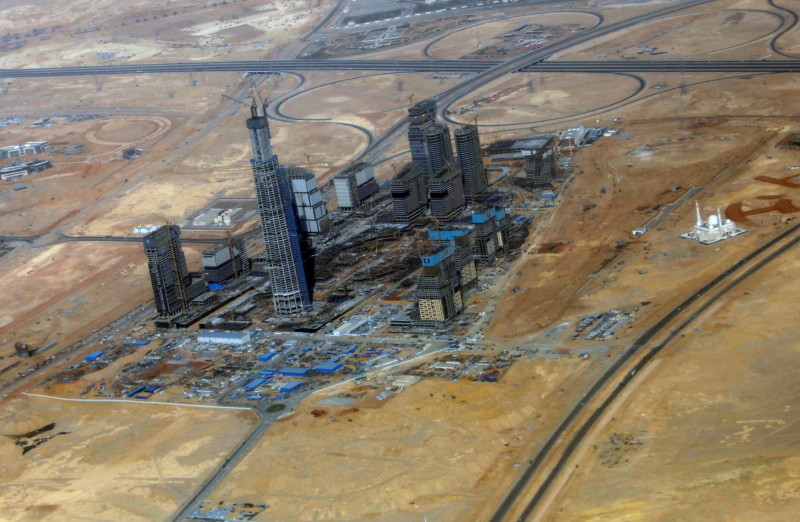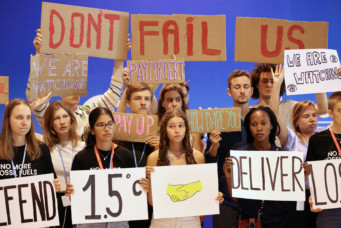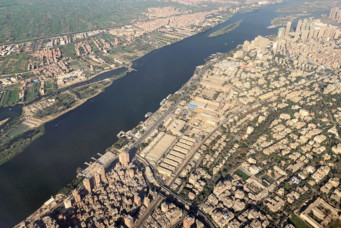COP27 and the Sustainable City: Global Climate Solution or Mirage?
The COP27 meeting in Sharm El-Sheikh highlighted the gap between climate policy goals and climate reality. In the MENA region and globally, cities are key to advancing climate goals

The New Administrative Capital is one of the most prominent examples of expanding urban cities in the Middle East, Egypt, April 10, 2021. Amr Abdallah Dalsh/Reuters
Cities are central to any discussion about climate change policy if for no other reason than that they create the most greenhouse emissions. They are also where most people live and where more of the world’s population will reside in the coming decades. Cities are responsible for an estimated 75 percent of climate emissions, despite the fact that they take up only 3 percent of the planet’s land surface. In addition to their current emissions, cities are likely to contribute more in the future due to projected increases in urban population and urbanization. The Sharm El-Sheikh Implementation Plan, which was revealed at COP27, recognizes the important role of cities in addressing climate change, but according to the UN-Habitat program, urban climate challenges and climate policies and responses do not always align. Furthermore, although global climate policy stresses the importance of cities, insufficient attention has been given to the intersecting issues of population growth, urban expansion, and urban sustainability.
The world’s urban population is expanding rapidly. In 2018, cities accounted for 55 percent of the world’s population and, by 2050, they will account for a whopping 68 percent, with an estimated 6.7 billion people living in cities alone. Most of that projected growth will occur in large cities, including new and existing megacities, which are home to a population of more than 10 million. Nine of the ten new megacities that will emerge between 2018 and 2030 will be in developing countries—two in Africa and seven in Asia. Accommodating this urban growth will have an impact on the climate and is likely to increase global greenhouse gas emissions. Although recent estimates indicate that urban growth will slow down after 2030, the current alarming rate begs the question of which development paths cities will take in response, and what impact they will have on climate emissions and policy. For instance, the UN Environment Programme estimates that 90 trillion dollars of urban infrastructure will be built by 2050 to accommodate the growing global urban population. Building urban infrastructure requires immense quantities of fossil fuel-dependent materials such as steel, concrete, and plastic. Feeding the growing urban population means increased food production which is unlikely to be sustained without increased use of mineral fertilizer, another fossil fuel input. Even with heroic efforts to minimize the carbon footprint of expanding cities, for example by implementing best green building practices, building efficient mass transit systems, and incorporating renewable energy systems, it is hard to envision that these cities can be built without risking added greenhouse gas emissions.
Another daunting aspect of future urban expansion fuelled by climate change is the migration of people from rural to urban areas, which has historically contributed to social unrest and tension in many parts of the world. Mass migration, especially to large cities, can worsen living conditions for the urban poor, increase strain on public services, and amplify existing social and economic inequality. If the specter of rising urban populations weren’t enough, cities are gobbling up land faster than they are growing population. Land sprawl is another issue that will extend the impact of global cities far beyond their current reach. Such sprawl not only increases the geographic boundaries of cities but also threatens to take over prime agricultural land and further worsen the impact of cities on natural systems and biodiversity.
If, as the COP27 parties recognized, we are currently falling far short of meeting our greenhouse gas emission targets, how will we meet them in a growing, more populated, and urbanized world? To do so will require future paths of urban development that are radically different from current approaches.
Although cities present many challenges to climate change, they may hold many of the keys to climate change solutions. Cities are central to global development policy, and are enshrined in international sustainable frameworks, most notably in the UN New Urban Agenda, which aims to fulfill the sustainable development target to “make cities and human settlement inclusive, safe, resilient and sustainable”—a goal that we are currently about as far from achieving globally as we are to meeting climate targets. Despite the tremendous challenges involved, the success or failure of mitigating, adapting to, and recovering from climate change will increasingly reside in the world’s cities.
Climate Change and Cities in the MENA Region
Climate change represents a major threat to cities in the Middle East and North Africa (MENA), but with varying degrees. The main threats to cities include extreme heat, water scarcity, sea level rise, and land sprawl.
Heat in the region’s cities has already increased by far more than in other regions of the world. By 2050, it may surpass the global average temperature by double, which is a major threat that will disproportionately affect the driest cities. Temperature increases in cities will be exacerbated by the “heat island effect” in which urban areas experience higher temperatures than outlying areas, as well as increased water loss from already arid systems which creates a desert warming amplification effect. Urban sprawl amplifies this effect because as cities grow larger, they also get warmer. The projected rise in temperatures will intensify water scarcity in an already water-scarce region, making water shortages, water policy, and water infrastructure key challenges for many cities in the region.
Sea level rise is another major threat for cities globally, and sea level rise in MENA is expected to cause coastal flooding in low-lying cities such as Basra, Iraq’s second largest city, and Alexandria, Egypt, which is one of the region’s most populous coastal cities. The region’s forty-two port cities, which are major economic and cultural hubs, will be affected and will need to adapt to rising seas. Egypt is especially vulnerable; the Intergovernmental Panel on Climate Change (IPCC) ranks the Nile Delta as one of the top three regions in the world most at risk from sea level rise.
A World Bank report noted that a 0.5-meter rise in sea level in Alexandria would displace 2 million people and cause 35 billion dollars of loss in land and property. The United Nations Development Programme has funded an innovative project for reducing the risk of coastal flooding due to sea level rise on Egypt’s North Coast. The project focuses on building 69 kilometers of sand dune dikes to help with adaptation, and developing an integrated coastal zone management plan for the area. It is a good example of possible sustainable solutions to climate adaptation because it implements a soft engineering approach that takes advantage of the natural ecosystem and engages the communities most likely to be affected by coastal flooding.
Alongside these environmental impacts, climate change may also drive or aggravate social and economic changes that could jeopardize climate adaptation and mitigation plans in the region. Climate change could exacerbate existing inequalities in cities, as the poorest citizens bear the greatest brunt of climate impacts. The IPCC has called climate change a threat multiplier that can exacerbate other drivers of poverty. Recent unrest due to escalations in food prices driven in part by the war in Ukraine illustrate the risks that climate-induced shocks to food production could pose to countries dependent on food imports. The costs of responding to other types of shocks induced by climate change, such as flooding and other extreme events, could detract from climate investments.
Rural-to-urban migration is an example of another social change that could exacerbate existing socioeconomic disparities within cities. Rural populations remain high in many countries in the region, including in Egypt where 57 percent of the population lived in rural areas in 2020. Many of these rural inhabitants rely on agriculture for their livelihoods, and climate impacts on agriculture may threaten their economic security. Under such conditions, migrants in the MENA region tend to move to large urban areas. The added population could worsen climate impacts in urban centers by exposing more low-income migrants to the urban heat island effect and extreme urban heatwaves. Cities that become refuge for climate migrants may themselves be overwhelmed by climate change, making it more difficult to sustain investments in climate mitigation and adaptation.
Climate change in megacities like Cairo is likely to exacerbate existing urban ills such as pollution, congested traffic, and aging infrastructure. On the other hand, rapid adoption of climate solutions could address many existing problems while making cities more resilient to both the environmental and social impact of climate change. For example, investing in better public transportation systems and creating incentives for switching to lower emission vehicles could help address air pollution problems. Building more renewable energy systems based on solar and wind, and upgrading the electricity grid, could also help reduce emissions. Increasing the amount of green space through planned urban renewal projects could help address the city’s abysmally low per capita green space, which has been sacrificed to road and infrastructure projects, and which will make the city even more unlivable in a warmer world. Developing better water use and wastewater strategies, including nature-based solutions, and incorporating more ecologically informed designs into urban and landscape planning designs could also improve Cairo’s climate resilience and livability. Collectively, such solutions offer a path toward the elusive goal of sustainable urban development (SUD) which must be the cornerstone to climate adaptation and mitigation in an increasingly urban world.
Sustainable Cities According to MENA Governments
Hosting back-to-back climate change conferences in the Middle East, with last year’s COP27 held in Sharm El-Sheikh, Egypt, and this year’s COP28 in Dubai, provides an opportunity to shine a light on the region’s climate challenges and how they are being addressed. The lead-up to COP27 was a good opportunity for governments to burnish the region’s green initiatives, many of which touch upon themes of green urbanism and SUD. The Go Green initiative launched by the Egyptian Ministry of Environment is one of several green initiatives the country has adopted as part of its National Sustainable Development Strategy, with a focus on environmental protection and natural resources. Several green initiatives in the region focus on SUD and building sustainable “green” cities. The Sustainable City in Dubai incorporates sustainable development goals into its planning, design, and construction, and is being touted as “the first operational net zero energy city in Dubai, modeled to become an international showcase for high quality sustainable living”. The motivating theme for this kind of development is the recognition of the threat of climate change, and the overwhelming need for a complete transformation of human systems in response to this crisis.
The branding for sustainable cities often offers an idealized green vision of sustainable development. The buildings are laid out in smart mixed-used conclaves and are powered with renewable and combined energy systems designed with maximal energy efficiency. All residences are within a five-minute walk to outdoor spaces with trees, shade, and other amenities. Public spaces include urban gardens and farms watered with smart water controllers, buzzing with bees and providing fresh local food. High-efficiency public transport systems are powered by renewable energy. Water systems reduce waste and include recovery of brown water for reuse with advanced sewage treatment systems that return some water through wetlands and are designed as important features of nature. Buildings and built surfaces are covered with solar panels tied to smart microgrids. This vision of the future MENA city has overtones of a green utopian fantasy, but many of these elements are being embraced globally as sustainable urban solutions for a just and livable future.
Governments have gone full steam on building sustainable cities that match their own visions of sustainable development. Egypt, for example, is working to reinvigorate urban development along greener lines through its Sustainable Cities Initiative. Launched at COP27, the Egyptian Sustainable Cities Initiative is providing 1.8 billion dollars to support thirty-three projects that address energy efficiency and renewable energy, green transportation solutions, and urban green spaces. Other urban sustainability efforts in Egypt include thirty planned “fourth-generation” cities built or being planned across the nation, all of which aim to create more sustainable, livable cities with lower environmental impact. In December 2022, Egyptian President Abdel Fattah El-Sisi and his cabinet celebrated the development of New Mansoura, an urban development being built on Egypt’s northern Mediterranean coast that is part of the government’s multibillion dollar effort to upgrade the nation’s infrastructure. The first phase of the project, which has a strong emphasis on sustainability, was completed last year, with ultimate plans for a city of 1.5 million people. Green aspects include an electric public rail system, buildings set two meters above sea level in anticipation of sea level rise, design-incorporated solar panels, and a minimum of 15 square meters of green space per person.
The New Administrative City is perhaps the most grandiose example of Egypt’s urban expansion. An even more futuristic vision is being played out in Saudi Arabia in plans for NEOM city, the 170-kilometer-long vertical skyscraper city envisioned by Crown Prince Mohammed Bin Salman. It is easy to get swept up by these enthusiastic visions for more sustainable cities, but they raise important questions relevant to sustainability: How will this substantial urban expansion be sustained? What impact will it have on climate change resilience and who will benefit from it?
Sustainable Cities and Global Climate Policy: Where the Rubber Meets the Road
Although global climate policy recognizes the importance of urban issues, it falls short in explicitly recognizing the outsized influence cities will have in finding sustainable paths forward. Future policies should explicitly emphasize the weighted contribution that cities make to both climate change and climate solutions. Globally, there needs to be better alignment between national, regional, and urban governance by establishing policies, developing plans, and investing in climate mitigation and adaptation. There also needs to be better recognition of the interrelated challenges of population growth, climate change, and environmental degradation, along with an honest assessment of energy resources, their use, and impact.
A major achievement at COP27 was agreeing to establish a loss and damage fund for poor nations to help them recover from climate disasters. These nations, mostly of the Global South, are the same ones experiencing the greatest urban growth and suffering from the lowest per-capita resources to deal with the burdens of that growth. Nor are they increasing their income or delivering core services that typically accompany urban growth in the Global North. The path toward sustainable urban development in these countries is likely to be much different from the path followed in more developed nations. It is difficult to envision how the green city schemes being developed by wealthier nations could be applied under such conditions. General concepts such as strategic intensification that includes high-density, mixed-use developments built around efficient mass transit and microgrid energy systems based on renewables might be applicable, but the particular mix of solutions will depend on geography, resources, wealth and governance systems, and approaches tailored to the reality of the local conditions in developing countries. By adopting development strategies that are less resource-intensive, these rapidly growing cities may have a lower impact on emissions than if they adopted strategies followed by the Global North.
The inequities between rich and poor countries may be magnified by the massive urban growth projected to occur in the Global South. There is currently a huge chasm between the stated financial commitments needed and the actual investments being made to address climate change. The current financial commitments, which range from the billions to hundreds of billions, fall far short of the actual investments needed, which likely run into the trillions. Countries in the Global South will have a difficult enough time meeting the basic needs of their expanding urban population, much less investing in climate adaptation and risk. The inequity between those who contribute the most to climate change and those who will suffer most from it is reflected in the world’s gross wealth inequity, which is as large within as it is between countries. A recent report from the World Inequality Lab shows that the wealthiest citizens are by far the greatest greenhouse gas emitters and that a modest progressive wealth tax on these top emitters could more than fill the climate adaptation funding gap.
Beyond the sheer limitations of financial investment, there is the problem of developing countries lacking the governance structures, political will, and financial wherewithal to adopt SUD strategies. There is wide recognition of the need for multilevel governance structures that include interaction between national, regional, and city level policies. Yet, cities remain key to reaching desired climate adaptation and mitigation goals. Independent civil society organizations, including environmental NGOs, local environmental groups, and climate action organizations have an important role in ensuring that citizens have a voice in climate policy, and that they can act as effective watchdogs over government-sponsored themes. Such inclusiveness is essential if Egypt is to live up to the “people first” approach that it proclaims in its plans for a green economy transition. Much emphasis in Egypt and elsewhere is placed on grand top-down schemes, but small-scale cooperation might end up being a more effective way to combat climate change than grand global agreements, and there is evidence that participatory processes are more effective at implementing SUD goals than non-participatory ones. People at all levels need to be included and dissenting voices need to be heard.
The allure of the green city creates an enticing vision of a future in which more people will have access to the amenities associated with a livable, sustainable future, but it raises the question of how equitably these amenities will be shared among the world’s future 6 to 7 billion urban residents. It also raises the question of how these expanded urban systems will be sustained, especially in a world with declining reserves of fossil fuels, despite an increased dependency on them.
Climate change is a symptom of the related issues of resource depletion, biodiversity loss, and environmental degradation. An important outcome of the COP27 meeting was the acknowledgment that these issues are interconnected and that we are pushing the boundaries of our planetary limits. President El-Sisi made implicit reference to these limits at the inaugural event for New Mansoura City where he stated, “With this level of population growth and the resources available to us, we are definitely ill-equipped.” Such a frank declaration of population and resource issues is a rare recognition that the world’s nations are reaching a tipping point in balancing growth with sustainability. Countries are also beginning to face the fact that these interrelated issues cannot be separated from issues of equality and social justice. The wealthiest nations and people have contributed the most emissions and they have a responsibility to help those who have created the least, and who will suffer the most harm.
Patrick J. Bohlen is Professor of Urban Ecology in the Biology Department at the University of Central Florida (UCF). He is also a Faculty Fellow with the UCF Center for Global Economic and Environmental Opportunity and is affiliated with the UCF Global Perspectives and International Initiatives Program. On Twitter: @PatrickBohlen.
Read MoreSubscribe to Our Newsletter





